The Top Ten Substance Abusers in Comics
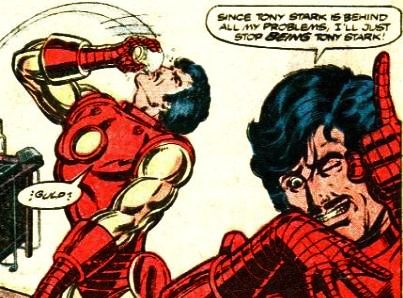 |
Drug addiction is a tricky subject to deal with taste and accuracy in any kind of fictional narrative, much less mainstream comic books, which are meant to entertain with stories about people with powers mostly hitting things more than anything else. Having said that, addiction to substances is a real world problem, and if modern comics are going to reflect the human condition in any way, then addiction to substances is something that has to come up occasionally. Whether or not they do it well is a matter of taste, I suppose, but nevertheless, here are ten characters who have taken have battled substance addictions and won, and some who lost.
Oh, and I’ve purposely skipped any of those “Hey Kids! Drug Are Bad!” comics made by Marvel and DC back in the day that you’d get for free in the nurse’s office in your elementary school. Despite being done by the same creators who did the real comics, they were always written at the very dumbest level for the unwashed masses, and were all out of continuity anyway. So there will be no mentions on this list of Captain America Goes to War Against Drugs! or any of those comics. Even the one where Mr. T accidentally takes LSD.
10. Hourman
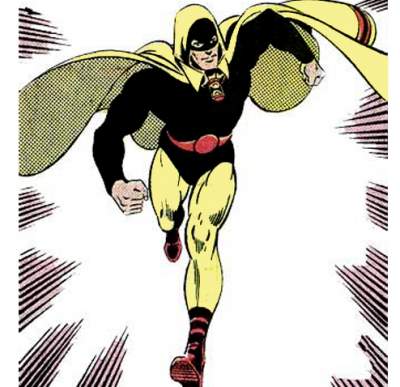 |
One of comicdom’s very earliest superheroes is also one of its first ever drug-addict cautionary tales. The Hourman was created in the Golden Age boom that followed the one-two punch debut of Superman and Batman during the previous two years. New superheroes were coming out of the woodwork at that time, on what must have seemed like a weekly basis. Hourman debuted in Adventure Comics #48 in March, 1940. Originally a chemist, Rex Tyler created a “miraculous” vitamin that increased strength and endurance which he unimaginatively named Miraclo. Embarking on a career as a crime fighter, Tyler took the name Hourman. Maybe not the smartest move, essentially shouting to the world that his power limitation is only one hour long, but it was a simpler time after all, so let’s give the creators a pass here.
Back then, having a superhero who got his powers from taking regular doses of a drug would not only have seemed perfectly okay for children’s stories of the forties, but the implications of greater power through the use of substances would have gone over the heads of any parents of the time who bothered to read it for themselves. Substance abuse, especially the abuse of illegal drugs in the form of pills, just wasn’t the epidemic it would become in later decades, or at the very least no one was talking about it yet if it was. The entire concept of “magic power pills” must have seemed totally innocent.
However, when Hourman re-emerged in the sixties and seventies as one of the “elder statesmen” heroes from the alternate Earth-2, comics had grown up enough to realize that a superhero who gets his powers from popping a pill every day is problematic, to say the least. In an a very early example of a comic book retcon, it was revealed that Rex Tyler was not only addicted to Miraclo, but addicted to the thrill of beating up criminals too, an early example of comics showing one of their superheroes having human weaknesses like addiction. DC would try to fix the Hourman problem in various ways, once even suggesting that the Miraclo pills were a placebo and he had a meta-gene that he could only access an hour at a time.
Eventually, his son Rick would become the second generation Hourman, and (surprise!) develop the same addictions as Daddy. He would eventually kick the habit as well, and his powers grew beyond just speed and strength for an hour, but to having precognitive flashes exactly one hour into the future, which is probably a more useful super power in a world where everyone is super strong and fast. A new version of Hourman is set to debut in the book Earth-2, and when he does, I’d bet real money that the “magic pills” are going to be a thing of the past once and for all.
9. Willow Rosenberg (Buffy the Vampire Slayer)
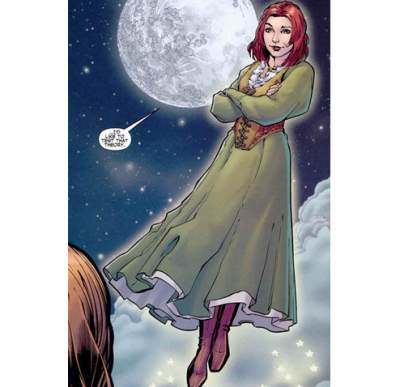 |
I admit, I’m cheating a bit on this entry, as Willow Rosenberg was first introduced in live action television by her creator Joss Whedon on Buffy the Vampire Slayer. Originally just Buffy’s nerdy sidekick and best friend, Willow began to dabble into magic and grew into a powerful witch as the series progressed. By season six of the series, she was powerful enough to resurrect Buffy from the dead, and began to become addicted to the high that magic provided. Pretty much everything on Buffy was a metaphor for something else, but Willow’s addiction was as “on-the-nose” as metaphors got on that show. She even had a “magic dealer” whose inter-dimensional apartment looked like it smelled of cat pee, like a real drug dealer’s place would (umm…so I hear.) Willow really went off the deep end when her girlfriend (fellow witch Tara) was murdered, and she absorbed so much black magic as to become a threat to the entire world.
The reason she is on this list however, is that Willow’s adventures, as well as elements of her addiction, linger on in Dark Horse Comics’ Buffy The Vampire Slayer Seasons 8 and 9 comics. In Season 8, Buffy destroyed something called “The Seed”, the source of all magic on Earth, cutting Earth off from other mystical dimensions. This means Willow suddenly had to go cold turkey off of magic, and has spent almost the entirety of the season 9 storyline trying anything and everything to bring magic back to the world. At first she said it was because the Earth was “broken” without it, but later she has admitted it is more because she is the one who needs it. Sounds like someone isn’t completely over their addiction just yet.
8. Patriot (Young Avengers)
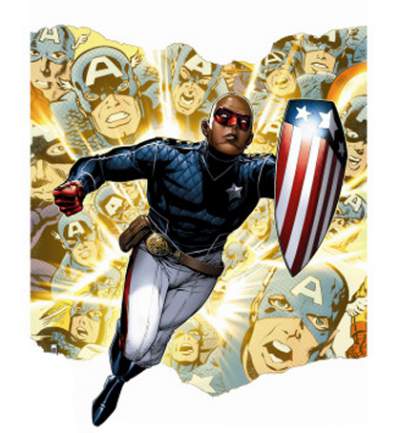 |
Marvel’s Young Avengers was a series no one thought would become a fan favorite when it was first announced back in 2005. Teenage versions of Thor, Hulk, Iron Man and Captain America? It sounded like a cheap knock off of DC’s Teen Titans. But the series ended up being pretty damn good, mostly thanks to writer/creator Allan Heinberg, and characters we thought were just going to be junior versions of the Avengers ended up being much more than that.
One character who surprised almost everyone with how cool he turned out to be was Patriot. Patriot was really Eli Bradley, a young African-American kid in a Captain America-esque costume, who turned out to be the grandson of Isaiah Bradley, the African-American Captain America first introduced in the mini-series Truth: Red, White & Black.
In Truth, it was revealed that Isaiah had received his powers as part of an early Super Soldier Serum experiment tested on African-American men in an attempt reproduce the formula that was lost after being used to turn Steve Rogers into Captain America back during World War II. Eli claimed that his powers came from a blood transfusion from his grandfather, which resulted in his receiving the super soldier abilities. But it was all a lie; Eli had no powers at all and was faking it, using Mutant Growth Hormone, a Marvel Universe version of steroids. Eventually, his fraud was exposed, and Eli stopped using the drugs. He was allowed to still lead the Young Avengers without powers, simply using his combat skills and natural abilities, and ended up taking a shot from a Kree warrior, saving Captain America. Gravely wounded, Eli then got a real blood transfusion from his grandfather, giving him powers for real, therefore ending his addiction to MGH for good. Although not a member of the current Young Avengers line-up, it is only a a matter of time before Patriot shows up again.
7. Batman
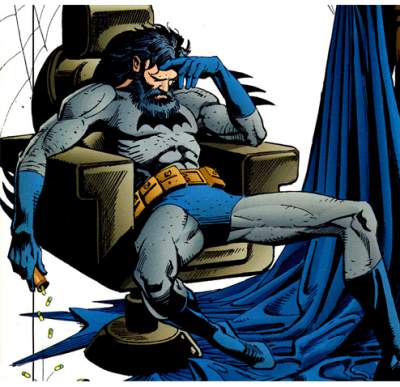 |
You might be wondering “when the Hell was Batman ever a drug addict?” Well, he was, at least for one story line from the early nineties Legends of the Dark Knight series entitled Venom. That particular story, written by comics legend Denny O’Neil, the man who returned Batman to his darker roots after the sixties television series, was set in Batman’s early “Year One” crime fighting days, as were all the stories in Legends of the Dark Knight, at least initially. The main plot of Venom involves an early failure of Batman’s that leads him to go to extreme measures to become more powerful. Sounds like a wee bit of Superman envy if ya ask me.
When Batman fails to save a little girl’s life because he wasn’t strong or fast enough, he begins obsessing about the life he couldn’t save. But thanks to a new drug he encounters that enhances his strength and agility called Venom, he becomes stronger and more aggressive…and pretty soon, full-on addicted as well. At one point during the story, he even fights and defeats a great white shark. Seeing as how this is Batman, he eventually faces his own limitations and at the end of the five issue storyline, and kicks the Venom habit once and for all. I have to say, I do applaud DC for doing this storyline, and making arguably their biggest icon a drug addict, for however briefly a period of time it was done. It shows that even the best of us can fall prey to drug addiction, and that it is something that even our biggest cultural icons on can go through. Okay, maybe real people struggle with addiction longer and find it a lot harder to kick, but this is Batman, he’s better than us at everything. As for the drug Venom, well…this being comics, this would not be the last time we hear of this made-up narcotic, which brings us to our next entry on this list…
6. Bane
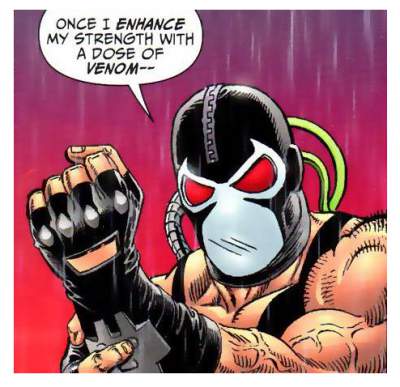 |
Not long after the Venom story arc in Legends of the Dark Knight, DC introduced what could be considered the last truly iconic foe created for Batman’s Rogue’s Gallery in the form of Bane. Much like Batman, Bane’s past is marred by tragedy. Coming from the fictional country of Santa Prisca, he was born and raised in a prison, a prison he was incarcerated in for the crimes of his father. As an adult, he was the test subject by the prison’s controllers for – you guessed it – the drug Venom. The experiments performed on him using the Venom compound nearly killed him at first, but of course he survived and found that the drug greatly increased his physical strength, although he needs to take it every 12 hours, through a system of tubes pumped directly into his brain. If he doesn’t do this, he suffers horrible side-effects and withdrawal pains.
Although his need for the drugs is not mentioned in his appearance in The Dark Knight Rises, in the comics, Bane’s addiction to Venom remains a central factor for the character. There are instances where he seems to have kicked the habit completely, and other instances where he seemed to be back on the stuff, although you can chalk that one up to editorial screw-ups more than anything. In a storyline in JSA Classified, Bane discovers that the drug is actually a derivative of the original Hourman’s drug Miraclo, thus tying Bane’s origins in with DC’s other most high profile addict.
5. Harry Osborn (from Spider-Man)
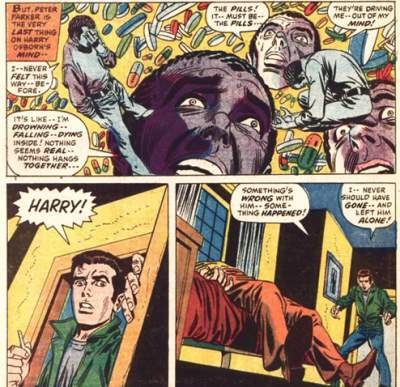 |
Harry Osborn was Peter Parker’s best friend going back to 1965, and more often than not, also the cause of many of his woes over the years. Harry was one of the very first characters in mainstream comics to deal with drug addiction head-on, going completely against the “no drugs” rule that the Comics Code Authority (the self-censoring institution created at the height of anti-comics paranoia) had for instituted for the better part of two decades up to that point. Back In 1971, the Department of Health, Education, and Welfare asked Stan Lee to write an anti-drug themed story into one of his Marvel titles. He agreed, and wrote a three-part story concerned with drug abuse that ran through Amazing Spider-Man #96, 97, and 98.
Ultimately, when Stan submitted the story to the Comics Code Authority, he was flat out turned down, because of the story’s depiction of drug use which went against the Code’s rules. The fact that the story was clearly anti-drug use, and was even done on request of the government, didn’t persuade the Comics Code people. Stan decided that the story was going to get printed regardless, and those issues were released without the Comics Code seal, the first Marvel books to do so.Not only did the world not explode as a result, but probably more parents were inclined to buy those issues for their kids than a regular issue of Spider-Man.
As for the story itself, it involves poor Harry Osborn, son of Norman Osborn, a.k.a. the Green Goblin, becoming addicted to…well, we’re not sure really. Stan Lee has said many times over the years that he knew nothing of drugs, so he kept it vague. Harry is clearly popping pills in that original story, so it looks like he’s addicted to some form of prescription drugs, but then he’s hallucinating like he’s on LSD (the drug of choice in the hippie era this came out in.) Harry’s drug addiction story wouldn’t just end in those three issues; it came up again and again, and because of it he even lost Mary Jane to his best friend Peter (maybe Spidey should send a thank you note to Harry’s drug suppliers.)
In later years, Harry would fall into drug addiction on several occasions. In some instances they said it was cocaine, other times meth, I think the writers were just throwing out the names of drugs they had heard of, and just ended up making it sound like Harry was doing every drug under the sun. Harry’s drug addictions were totally glossed over for the Sam Raimi movie trilogy, where he was played by James Franco, and it remains to be seen if the version we are getting of the character for The Amazing Spider-Man 2 will tackle this aspect of his personality. But I wouldn’t hold my breath.
4. Morbius, the Living Vampire
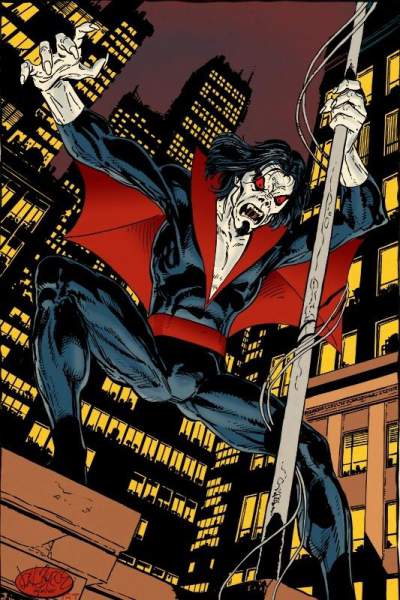 |
Almost every vampire in modern fiction is a metaphor for drug addiction on some level, from Barnabas Collins on Dark Shadows, to Anne Rice’s Lestat, to Angel from Buffy. Even sparkly Edward from Twilight compares Bella to “his own personal brand of heroin.” (I can’t believe I just quoted Twilight for anything. First and last time folks, I promise.) Maybe no modern era vampire has exemplified the struggle with addiction better than Marvel Comics’ Michael Morbius, the Living Vampire. Morbius originally appeared as an antagonist for Spider-Man in 1971, a mere few months after the Comics Code ban on both drug stories and vampire stories was lifted, in a way allowing Morbius to become the poster boy for both, although the drug in this instance was only metaphorical in nature.
Michael Morbius was a nobel prize-winning scientist who struggled with a rare blood disease; in an effort to rid himself of it, he attempted to cure himself with a treatment involving vampire bats and electroshock therapy. (because those two things always go together like peanut butter and jelly.) Instead of getting cured, he became afflicted with “pseudo-vampirism,” which was really just regular vampirism without the supernatural overtones and weaknesses. Like a regular vampire, Morbius now had to digest blood in order to survive and had a strong aversion to light. He could also fly, had superhuman strength, speed, and healing abilities like a regular vampires, and he could make other “living vampires” like himself.
Although he came into conflict with Spider-Man, after his first few appearances as a villain, he was spun off into his own feature as more of an anti-hero. In almost all of those early stories, Morbius is seen lamenting his own addictions, staying away from ordinary humans as they were too much temptation for him to handle. Eventually, Morbius gave in to his need for blood, although he would only drink the blood of the guilty.
3. Karen Page (from Daredevil)
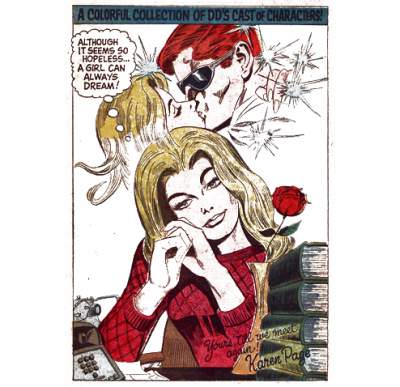 |
The Marvel Universe is filled with hard-luck cases, characters whose lives seem beset by tragedy after tragedy. But maybe the Marvel character who has had the most tragic existence isn’t one you might have ever even heard of, as she isn’t a household name like other superhero love interests like Lois Lane or Mary Jane Watson. Introduced in Daredevil #1 in 1964, Karen Page was Matt Murdock’s pretty, blonde wide-eyed secretary, who was in love with both Murdock and infatuated with his alter-ego Daredevil. Sounds like every superhero girlfriend right? Trust me, this is where the similarities end between Karen Page and the likes of Pepper Potts, Jane Foster, etc.
In a rare move for super hero comics back in the Silver and Bronze Age, Matt Murdock let Karen in on his secret double life, a fact that she ultimately couldn’t handle due to the constant worrying about whether or not her boyfriend was going to come home in one piece or not. She left him and moved to California to pursue a career in acting, and although she landed a role in a soap opera, it wasn’t long before Karen was lured by the dark side of Hollywood, and became a heroin addict. She starred in porno flicks as a way of getting money for her drug addiction. Her life became a bad Lifetime television movie.
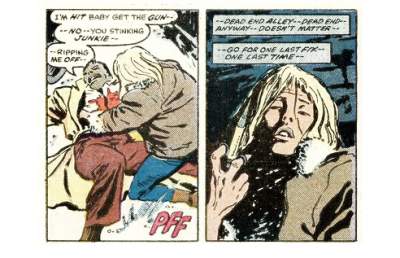 |
In Frank Miller’s Born Again storyline, Karen, in desperate need of a heroin fix, sells Daredevil’s secret identity to some random drug dealer she knows, who in turn sells it to the Kingpin, Daredevil’s arch foe. Karen is then forced to return home to New York, where she once again resumes a relationship with Matt Murdock. He helps Karen recover from her addiction, but their love affair doesn’t last very long this time, as Matt cheats on her with villainess Typhoid Mary. You’d think after selling him out to his #1 foe that one time and ruining his life, he might get a pass on the whole affair thing, but no, that’s the end of that relationship. Although she successfully beat her drug addiction, the road ahead was still ugly for poor Karen. She ultimately discovered she had AIDS, and not long after was killed by the hitman Bullseye in an attempt to at revenge on Daredevil, cementing her as maybe the most tragic case of any Marvel Universe character.
2. Speedy/Roy Harper (later Arsenal and Red Arrow)
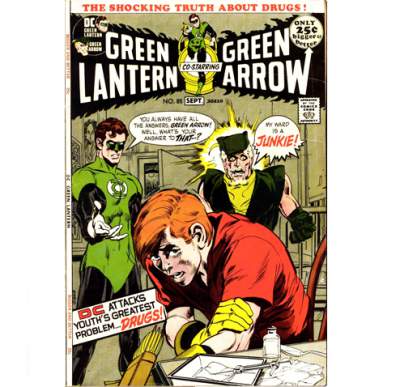 |
One of the most famous covers ever dealing with illegal drugs was the cover to Green Lantern/Green Arrow #86, where a shocked and dismayed Green Arrow/ Oliver Queen walks in on his ward Speedy/Roy Harper, shooting up and surrounded by heroin paraphernalia, and shouts “My Ward is a JUNKIE!” This is pretty shocking stuff for a mainstream comic in 1971, especially a DC comic, who until now were seen as kid books compared to Marvel’s more teen friendly fare. Between Harry Osborn in Amazing Spider-Man and this, 1971 was the year that drugs and addiction finally became a non-taboo subject in American comics.
Speedy was originally just the Robin to Green Arrow’s Batman; a teen orphan taken in by a rich playboy superhero as his ward and sidekick. He also appeared on and off during the sixties as the unofficial “fifth” member of the Teen Titans, before joining the team full time. By the early seventies Teen Titans got cancelled, and not long after, his father figure Green Arrow lost all his money and took off on an extended road trip with his buddy Green Lantern, leaving teenage Roy behind to figure out how to pay the bills and fight crime alone. It was around this time that he appeared as a heroin addicted kid in the pages of Green Lantern/Green Arrow. And when Roy’s addiction was exposed, Green Arrow’s reaction wasn’t to get Roy help, nope…it was to angrily punch him and throw him out. (It was Green Lantern and Black Canary who helped Roy get clean after Oliver Queen turned into a total asshole dad.) Although Roy pretty much got clean after that two part story, his bout with addiction turned his character from a wannabe Robin into something else, and colored all of his appearances as a character from there on out. He was a frequent guest star in the New Teen Titans, where we find out he had become an operative for a fictional DEA type agency.
Although Roy remained clean for the following several decades, and even earned a spot on the Justice League as Red Arrow, in the 2007 mini-series Justice League: Cry for Justice, his young daughter Lian was killed, leading Roy down the path of addiction yet again, to the point where he takes out his anger on a group of drug dealers in an alley, steals their drugs, and hallucinates that a dead alley cat is his daughter (not DC’s shining moment.) He then finds one of the people partially responsible for his daughter’s death and butchers them. Although he was once again clean and sober after all this, the New 52 reboot retconned away all of his history away, so now Roy (going by Arsenal) not only never had a daughter, he also possibly never struggled with heroin addiction. As a member of the Outlaws, it is said that he was an alcoholic, and for some reason had Batman villain Killer Croc as his sponsor. Okay, DC, if you say so.
1. Iron Man
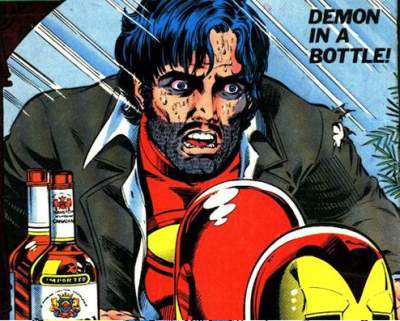 |
Seriously, who else was going to make it to the #1 slot? Arguably the most beloved addict in all of super hero history, and one could even argue that his alcohol addiction is what made Iron Man stand apart from other superheroes at the time. Unlike Batman, whose addiction was introduced in a five-issue series and then never really dealt with again, Tony Stark’s addiction is a huge part of who he is as a character to this day. Although not originally portrayed as an alcoholic when he was introduced in the sixties, Iron Man was still often see with a drink in his hand, a typical Mad Men era playboy with a mini bar in every room. But in early 1979, writer David Michelinie started a nine part storyline that admitted finally that the Armored Avenger was an alcoholic, a story remembered today as Demon in a Bottle.
Unlike Batman, Tony’s addiction was portrayed far more realistically, as he fell off the wagon a few more times before finally becoming truly clean and sober for good. (Although the Scarlet Witch once altered reality so Stark was technically drunk while never having actually having had a drink, becoming an angry drunk while speaking before the UN. This is one of those times when the Scarlet Witch was crazy/evil. She got better.) Chaos magic aside, Tony has for the most part stayed clean and sober these last few decades.
Interestingly, Iron Man is now a household name and arguably the defining super hero of the modern era thanks to Robert Downey Jr’s portrayal of him in the movies. And yet, aside from showing a drunk Iron Man acting the fool and trashing his own house in Iron Man 2, there really is never a moment in these movies where Iron Man acknowledges that he is an alcoholic, and Disney officially nixed writer Drew Pearce from acknowledging Tony’s alcoholism in Iron Man 3. Considering he was having nervous breakdowns over the events of Avengers in that movie, you’d think this might have been the right time to bring up the alcoholism storyline.
Or, if that were too much to properly do justice to in a two hour action movie (which, to be fair, it would be), maybe an acknowledgment that he doesn’t drink anymore would have been enough, something like someone offering him a cocktail and Tony saying “sorry, I don’t partake.” It would have been something to suggest that maybe between films, Tony had acknowledged he had a problem and now had stopped drinking. Certain nerds complain endlessly that the Disney failed to give us Iron Man’s real arch villain the Mandarin in Iron Man 3, but Iron Man’s true #1 villain is alcohol, and that was even swept more under the rug.
Previously by Eric Diaz:
Nine Reasons a Flash TV Show Could Be Better Than a Flash Movie
The Ten Heroes Most Unworthy Of Justice League Status (Who Joined Anyway)
